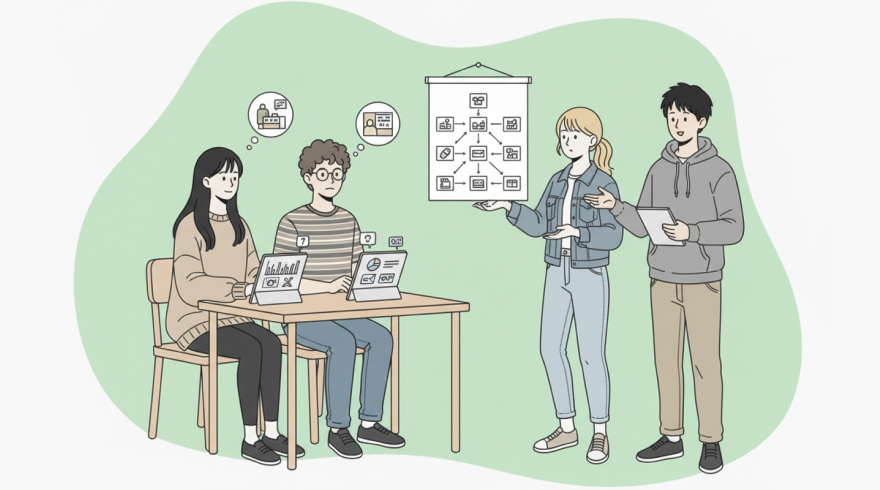The Complete Guide to Online Career Evaluation for Confident Decisions
- 8 October 2025

Digital psychometrics brings structure and evidence to career exploration for students, job changers, and leaders. Across the talent landscape, professionals turn to online career assessments to gauge fit and gather structured feedback. These instruments translate responses into measurable profiles, revealing strengths, blind spots, and motivators. When properly designed, they adhere to validity standards and minimize bias through research-driven item construction. That rigor is why organizations and universities weave them into guidance programs.
Beyond exploration, hiring contexts also depend on data-rich exercises to predict role performance. In many cases, candidates practice with an online job assessment test to understand typical formats and behavioral expectations. Preparation builds familiarity with time limits, adaptive logic, and situational scenarios. Used ethically, these exercises complement interviews rather than replace human judgment.
Different platforms package capabilities in diverse ways, spanning personality, values, and skill diagnostics. To navigate the market, seekers often compare online career assessment tools by validity evidence, reporting depth, and accessibility features. Clear documentation, sample reports, and transparent scoring help separate rigorous offerings from superficial quizzes. The right mix elevates confidence and accelerates meaningful career decisions.
- Cognitive reasoning and problem-solving patterns across novel tasks
- Work styles, temperament, and interpersonal tendencies at work
- Interests, values, and purpose signals that sustain motivation
- Domain skills, transferable competencies, and learning agility
- Cultural preferences, team fit, and collaboration dynamics
Benefits, Use Cases, and Tangible Outcomes for Individuals and Employers
The primary payoff of using structured evaluations is better self-knowledge that converts into action. For many individuals on a budget, a thoughtfully designed free online career assessment can spark reflection and create an initial development roadmap. Clarity about strengths reduces decision fatigue and prevents costly training detours. Coaches can then translate findings into crisp goals with timelines and milestones.
Employers gain measurable benefits as well, from reduced turnover to smoother onboarding. During early screening, a standardized free online job assessment test offers consistent signals without introducing scheduling friction. Consistent frameworks help compare candidates fairly while documenting job-related criteria. That consistency supports compliance and improves stakeholder trust.
Learners and career changers also value portability, since reports travel easily between mentors, bootcamps, and career centers. When validation is robust, a carefully selected free online career assessment test can complement premium diagnostics for a multi-layered perspective. Layering multiple perspectives prevents overreliance on any one instrument and expands insight. As a result, development plans become realistic and motivating.
- Sharper career hypotheses and faster iteration through real-world tests
- Evidence-backed learning priorities that focus limited time and budget
- Better employer–employee matching and stronger retention outcomes
- More inclusive access through remote, device-agnostic delivery
How to Choose, Compare, and Interpret Results Responsibly
Choosing wisely starts with clarifying your goal, whether that is discovery, upskilling, or hiring. If you are budget-conscious, you might shortlist a career assessment test free online and verify that it explains constructs in plain language. Next, examine technical manuals to spot reliability coefficients and norm groups. Finally, preview report samples to ensure results translate into actions.
| Feature | Why it matters | What to look for |
|---|---|---|
| Validity and reliability | Ensures the instrument measures what it claims, consistently across time and users. | Technical manuals, peer-reviewed evidence, clear purpose statements. |
| Norm groups | Provides context so scores are interpreted relative to appropriate populations. | Recent, diverse samples with transparency on size, region, and roles. |
| Accessibility | Guarantees inclusive use for people with varying abilities and devices. | WCAG compliance, screen-reader support, language and contrast options. |
| Reporting quality | Turns raw data into practical guidance for next steps and coaching. | Behavioral examples, visuals, development tips, and cautions for use. |
Reading results well is just as important as selecting the instrument, because misinterpretation can mislead decisions. For broader exploration, you may combine multiple free online career assessment tools to triangulate themes before committing to training. Synthesis turns raw scores into narratives that matter for job search, networking, and learning plans. A reflective journal paired with mentorship sessions closes the loop effectively.
Organizations should collaborate with industrial-organizational psychologists when stakes are high. Under formal hiring protocols, leaders sometimes deploy online career assessment tests alongside structured interviews to increase signal quality. To maintain fairness, they calibrate cut scores, monitor adverse impact, and train assessors. Documentation and audits keep processes defensible over time.
Practical Steps to Get Started Today
Getting started is straightforward and rewarding when you approach the process deliberately. After setting a realistic timeline, you can select an evidence-based online career assessment that fits your immediate decisions and context. Then schedule time to complete it without distractions and save your raw reports securely. A follow-up review a week later helps you separate momentary mood from enduring patterns.
Interests deserve special attention because curiosity sustains energy through learning curves. To explore motivations deeply, you might add an online career interest assessment once you have a baseline profile in hand. Comparing results across tools reveals converging themes you can test through projects. Short experiments, such as job shadowing or micro-internships, turn insight into experience.
- Define your primary goal and the timeframe for making a decision
- Pick two credible instruments with complementary lenses
- Block quiet time, answer honestly, and avoid multitasking
- Annotate each report and highlight repeating patterns
- Form three career hypotheses and design small experiments
- Review outcomes with a mentor and update your roadmap
FAQ: Quick Answers to Common Questions
- Are these evaluations scientifically valid?
Many high-quality instruments are based on peer-reviewed research and documented validation studies. Reputable providers publish technical manuals detailing constructs, reliability, and proper use. If uncertain, consult a counselor or industrial-organizational psychologist for guidance.
- Will results limit my options or label me permanently?
No single profile defines your potential. Credible frameworks focus on ranges rather than fixed categories. Treat outputs as hypotheses to test through projects, conversations, and learning experiences. Skills and interests evolve, and your plans should adapt over time.
- How often should I retake an assessment?
Most people retest after a major career shift, new education, or every 12–18 months to track growth. In hiring contexts, companies use assessments at defined stages for consistency. Outside of selection, retesting can be timed around significant life or role changes.
- Can these tools help career changers pivot successfully?
Yes. Structured feedback highlights transferable strengths and areas for improvement. Pairing insights with targeted courses, volunteer projects, or micro-internships helps validate direction. Mentorship and networking accelerate learning and opportunity discovery.
- What privacy practices should I expect from providers?
Trustworthy providers clearly explain data collection, storage, and sharing practices, and allow deletion on request. Look for encryption, clear consent language, and limited access to raw responses. For hiring purposes, ensure policies on rights and retention are transparent to participants.
Latest News
-
![The Ultimate Guide to Career Fit Assessments: Methods, Benefits, and Real-World Use]() The Ultimate Guide to Career Fit Assessments: Methods, Benefits, and Real-World Use Deciding what to do with your work life can feel exhilarating and overwhelming at the same time. Between evolving industries, shifting job titles, and new technologies, it’s easy to lose sight of the roles that actually match your strengths. Structured evaluations bring clarity by translating...
The Ultimate Guide to Career Fit Assessments: Methods, Benefits, and Real-World Use Deciding what to do with your work life can feel exhilarating and overwhelming at the same time. Between evolving industries, shifting job titles, and new technologies, it’s easy to lose sight of the roles that actually match your strengths. Structured evaluations bring clarity by translating... - 12 October, 2025
-
![Ultimate Guide to No-Cost Career Tests: Choose a Path With Confidence]() Ultimate Guide to No-Cost Career Tests: Choose a Path With Confidence Choosing a direction in work feels easier when you have structured feedback, clear language for your strengths, and a map of roles that fit. Robust assessments translate your interests, values, and personality into practical options, and they reduce blind spots that otherwise slow down growth. Inste...
Ultimate Guide to No-Cost Career Tests: Choose a Path With Confidence Choosing a direction in work feels easier when you have structured feedback, clear language for your strengths, and a map of roles that fit. Robust assessments translate your interests, values, and personality into practical options, and they reduce blind spots that otherwise slow down growth. Inste... - 11 October, 2025
-
![A Complete Guide to Mapping Interests to Meaningful Careers]() A Complete Guide to Mapping Interests to Meaningful Careers Choosing a vocation becomes simpler when you understand your enduring likes, dislikes, and motivational triggers. Instead of guessing, you can rely on structured tools that illuminate patterns across activities, environments, and tasks. These tools reveal how you prefer to solve problems, collaborat...
A Complete Guide to Mapping Interests to Meaningful Careers Choosing a vocation becomes simpler when you understand your enduring likes, dislikes, and motivational triggers. Instead of guessing, you can rely on structured tools that illuminate patterns across activities, environments, and tasks. These tools reveal how you prefer to solve problems, collaborat... - 10 October, 2025



